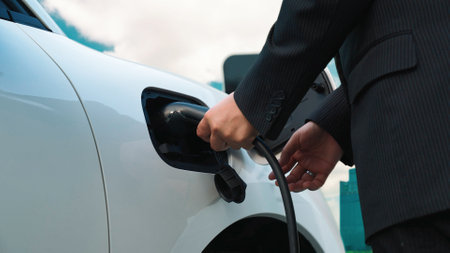Introduction to Car Battery Maintenance in the UK
When it comes to keeping your vehicle in peak condition, battery maintenance is often overlooked by many British motorists. The UKs unique climate—characterised by frequent rain, damp conditions, and fluctuating temperatures—can take a toll on car batteries, whether you drive a petrol, diesel, or electric vehicle. Coupled with typical British driving habits, such as shorter commutes and stop-start city journeys, these factors make routine battery care crucial across the country. A well-maintained battery not only ensures reliable starts on frosty mornings but also helps prevent unexpected breakdowns in unpredictable weather. Understanding the specific demands of the UK environment and adapting your maintenance routine accordingly is essential for prolonging battery life and maximising vehicle performance.
2. How Climate and Driving Patterns Affect Battery Life
The UK’s unique combination of damp, chilly weather and frequent short urban journeys can be particularly challenging for car batteries, whether you drive a petrol, diesel, or electric vehicle. British winters rarely plummet to extreme lows, but the persistent cold and moisture can slow down chemical reactions inside conventional lead-acid batteries, reducing their efficiency and lifespan. Additionally, short trips in town—common for many UK drivers—do not allow the battery to recharge fully, leading to gradual depletion over time.
Impact of Weather and Urban Driving
| Factor | Effect on Battery | Tips for UK Drivers |
|---|---|---|
| Damp Conditions | Can cause terminal corrosion and leakage | Regularly inspect and clean battery terminals |
| Cold Temperatures | Lowers battery capacity and starting power | Consider battery blankets or keep your car in a garage |
| Short Urban Trips | Batteries may not fully recharge; risk of deep discharge | Take occasional longer drives or use a smart charger |
Petrol & Diesel Vehicles
Traditional cars rely heavily on their starter batteries, which work hardest during ignition. In colder months, oil thickens and engines require more power to turn over, putting extra strain on older batteries. Frequent stop-start traffic common in towns like London or Manchester increases this demand further. To mitigate issues, UK motorists should check voltage regularly and replace ageing batteries before winter sets in.
Electric Vehicles (EVs)
EVs behave differently under the same conditions. While lithium-ion batteries are less affected by cold than lead-acid types, range reduction is noticeable in winter due to increased heating demands and slower charging rates. For city dwellers making lots of short journeys, pre-conditioning the cabin while plugged in and scheduling regular full charges can help maintain performance.
Key Takeaways for British Drivers
- Keep terminals clean and dry to prevent corrosion from damp air.
- If possible, store vehicles indoors during the coldest months.
- Invest in a trickle charger if you frequently make only short trips.
By understanding how Britain’s climate and driving habits affect battery health across different vehicle types, you can adopt simple practices that prolong battery life and ensure reliable starts all year round.

3. Petrol Car Batteries: Maintenance and Best Practices
Petrol cars across the UK almost universally rely on 12V lead-acid batteries, a tried-and-tested technology that has powered British vehicles for decades. These batteries are responsible for starting the engine and running essential electrical systems when the ignition is off. In typical British driving conditions—think short urban journeys, frequent stop-start traffic, and variable weather—petrol car batteries can face unique challenges. Frequent short trips common in UK towns and cities may not give your alternator enough time to fully recharge the battery, leading to gradual depletion over time.
Common failure points include sulphation (where lead sulphate crystals build up due to undercharging), corrosion of terminals (often accelerated by damp UK winters), and old age—most 12V lead-acid batteries last around 4-5 years under average British use. Cold snaps, notorious in the UK winter, further stress ageing batteries and can leave you stranded on frosty mornings.
To maximise lifespan and reliability, regular checks are essential. Inspect battery terminals for signs of corrosion and ensure they’re tightly secured; a dab of petroleum jelly can help prevent oxidation. If your car is left unused for extended periods (common with commuters using public transport part-time), consider using a trickle charger or battery maintainer to keep charge levels healthy. Always ensure that all lights and accessories are switched off before leaving your vehicle—accidentally leaving sidelights on overnight is an easy mistake in the darker months.
Lastly, investing in a quality replacement battery from a reputable supplier is important when it’s time for renewal. Look out for batteries that meet or exceed your manufacturer’s original specification, and if you’re unsure about fitting it yourself, most UK garages offer straightforward installation services as part of their MOT or servicing packages.
4. Diesel Vehicle Batteries: Key Differences and Care Tips
Diesel cars remain a popular choice for many UK motorists, particularly those covering higher mileages or requiring more torque for towing. However, the demands placed on their batteries differ significantly from petrol or electric vehicles. Understanding these differences is key to ensuring reliable starts, especially during Britains colder months.
Demands of Diesel Engines on Batteries
Unlike petrol engines, diesel vehicles require more power to start because they operate at higher compression ratios. This means the starter motor draws more current from the battery. Additionally, many diesel models are equipped with glow plugs, which pre-heat the combustion chamber to aid cold starts—placing extra demand on the battery during winter.
Comparison of Battery Demands
| Vehicle Type | Battery Power Required (Starting) | Additional Features Affecting Battery |
|---|---|---|
| Petrol | Lower | Spark Plugs |
| Diesel | Higher | Glow Plugs, Higher Compression Starter Motor |
| Electric | N/A (for propulsion), Moderate (for 12V systems) | Auxiliary Systems Only |
Caring for Your Diesel Car Battery in the UK Climate
Batteries in diesel vehicles can struggle during British winters due to lower temperatures affecting battery efficiency and increasing the need for glow plug use. To avoid inconvenient breakdowns or failed starts, regular maintenance is essential.
Essential Checks for UK Drivers:
- Test Battery Voltage: Use a voltmeter monthly—healthy batteries should read around 12.6 volts when fully charged.
- Inspect Terminals: Clean any corrosion and ensure terminals are tightly secured, as loose connections can cause starting issues.
- Monitor Glow Plug Warning Light: If this light stays on longer than usual, it may indicate failing glow plugs or a weak battery.
- Check for Slow Starts: Hesitation or sluggish cranking is a sign your battery may be struggling, especially in colder weather.
- Replace Aged Batteries Promptly: Diesel vehicle batteries typically last 4-5 years; consider proactive replacement before winter sets in.
Top Tip:
If your journeys are usually short, invest in a smart charger or take an occasional longer drive to ensure your battery reaches full charge—a common issue among city drivers in the UK where frequent stop-start motoring can reduce battery life.
5. Electric Vehicle (EV) Batteries: Maintenance and Charging Habits
Modern electric vehicle (EV) batteries represent a significant leap from their petrol and diesel counterparts, not just in chemistry but in how British drivers must care for them. Unlike traditional lead-acid batteries, most EVs use advanced lithium-ion packs, which offer higher energy density and longer lifespans. However, maximising their performance in the UKs unique climate and infrastructure requires targeted strategies.
The UKs EV charging network is rapidly expanding, with dedicated home wallboxes, public rapid chargers, and an increasing number of workplace facilities. While urban areas like London, Manchester, and Birmingham are well-served, rural regions may still face limited access. This makes planning journeys—and charging sessions—especially crucial for UK drivers keen to avoid “range anxiety.”
Optimising EV battery health starts with mindful charging habits. Experts recommend maintaining your battery’s charge between 20% and 80%, avoiding frequent “top-ups” to 100% unless preparing for a long trip. In colder British winters, pre-conditioning the car while it’s plugged in can help preserve battery capacity by ensuring it reaches optimal temperature before driving. Similarly, parking in a garage or shaded area during heatwaves helps reduce thermal stress on the battery cells.
Unlike petrol or diesel cars, EVs have minimal maintenance requirements—there’s no need for regular oil changes or exhaust checks. Still, routine software updates from manufacturers often include battery management improvements tailored to evolving UK road and weather conditions. It’s wise to schedule these updates during off-peak electricity hours, which can also be cheaper thanks to flexible UK energy tariffs.
Ultimately, understanding both the capabilities of modern EV batteries and the nuances of Britain’s charging landscape empowers motorists to prolong battery lifespan and enjoy reliable, efficient driving year-round.
6. Common Issues and Troubleshooting for UK Drivers
British drivers encounter a variety of battery-related problems across petrol, diesel, and electric vehicles, particularly given the UKs often damp and chilly climate. Flat batteries are a common sight on British roads, especially after cold snaps or periods of inactivity. For traditional petrol and diesel cars, frequent short journeys can prevent the battery from fully charging, leading to sluggish starts or total failure. Electric vehicle (EV) owners may notice reduced range or longer charging times during colder months.
Jump Starting: A Quick Fix
If your car refuses to start, jump starting is a tried-and-true method for petrol and diesel models. Always use quality jump leads and ensure both vehicles are safely positioned with engines off before connecting. Attach the positive lead to the flat battery first, then connect to the donor vehicle. Negative leads go to an unpainted metal surface away from the battery. Allow the donor engine to run for a few minutes before attempting ignition. Remember, never attempt to jump start an EV—seek professional help as their high-voltage systems require specialist attention.
Roadside Assistance: When DIY Isnt Enough
Membership in UK breakdown services such as the AA, RAC, or Green Flag is invaluable. These providers can address flat batteries quickly, either with portable chargers or by towing you to safety if needed. In remote locations or during adverse weather, calling for assistance is often safer than self-repair.
Knowing When to Replace Your Battery
Regularly inspect your battery for warning signs: slow engine cranking, dim headlights, dashboard warning lights, or visible corrosion on terminals. Most car batteries last between three to five years in the UK climate, but heavy urban use or harsh winters can shorten this lifespan. If you experience repeated jump starts or notice persistent electrical issues, it’s time for a replacement. EV drivers should monitor dashboard diagnostics for alerts about cell health; while main traction batteries typically last much longer, 12V auxiliary batteries in EVs also need periodic checks.
Staying vigilant about these common issues ensures you wont be left stranded on British roads—whether youre driving through London traffic in a petrol hatchback, tackling rural lanes in a diesel estate, or navigating city congestion in an electric car.
7. Conclusion: Keeping Your Car Battery Healthy Year-Round
Maintaining your car battery is crucial for reliable motoring across the UK’s ever-changing seasons, whether you drive a petrol, diesel, or electric vehicle. Understanding the specific needs of each powertrain type is the first step towards avoiding inconvenient breakdowns and costly replacements. With colder winters and unpredictable wet weather, batteries face extra strain—especially in diesels and EVs—while summer heat can also accelerate wear. A proactive approach tailored to UK driving conditions makes all the difference.
Seasonal Checklist for UK Car Owners
- Winter: Check battery charge regularly, especially before long journeys; clean terminals to prevent corrosion from damp and road salt; ensure lights and heaters aren’t left on unnecessarily.
- Spring: Inspect for winter damage and test battery health; top up fluids if applicable (petrol/diesel); recalibrate or check EV charging routines after cold spells.
- Summer: Park in shade where possible to reduce heat stress; check electrolyte levels in traditional batteries; monitor high-voltage systems in EVs after longer drives or rapid charging sessions.
- Autumn: Prepare for colder months by testing battery output; clear drains around the battery bay to avoid water ingress; review manufacturer recommendations for your vehicle type.
Peace of Mind All Year Round
By following these simple yet effective seasonal checks, UK drivers can minimise the risk of battery failure whatever the weather. Remember: regular maintenance not only ensures your vehicle starts first time but also extends battery life—saving money and reducing hassle. Investing a little time now gives lasting confidence on Britain’s roads, rain or shine.


